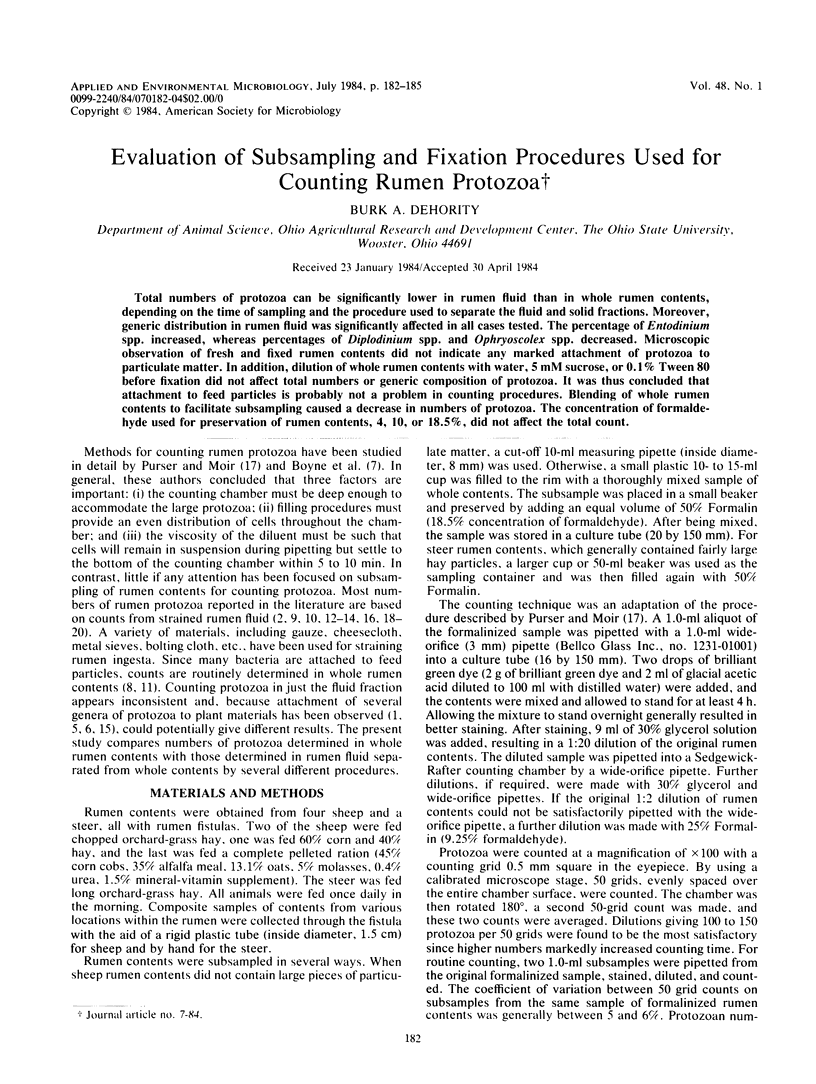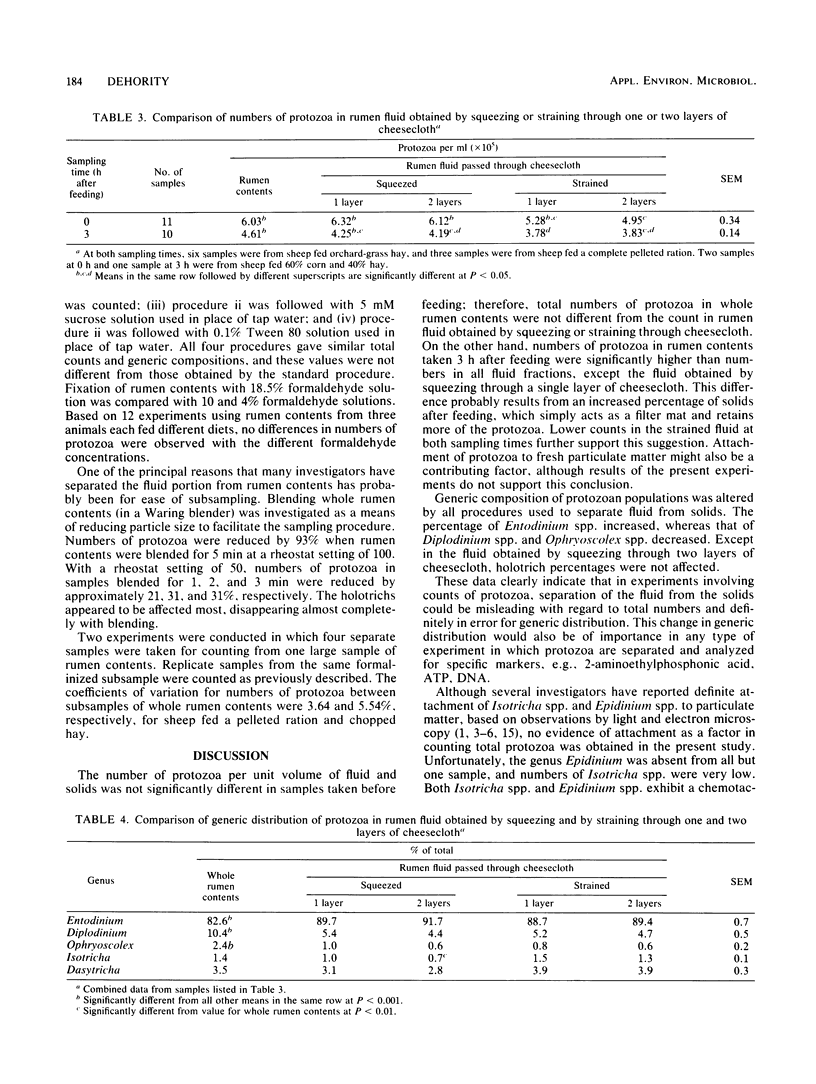Abstract
Total numbers of protozoa can be significantly lower in rumen fluid than in whole rumen contents, depending on the time of sampling and the procedure used to separate the fluid and solid fractions. Moreover, generic distribution in rumen fluid was significantly affected in all cases tested. The percentage of Entodinium spp. increased, whereas percentages of Diplodinium spp. and Ophryoscolex spp. decreased. Microscopic observation of fresh and fixed rumen contents did not indicate any marked attachment of protozoa to particulate matter. In addition, dilution of whole rumen contents with water, 5 mM sucrose, or 0.1% Tween 80 before fixation did not affect total numbers or generic composition of protozoa. It was thus concluded that attachment to feed particles is probably not a problem in counting procedures. Blending of whole rumen contents to facilitate subsampling caused a decrease in numbers of protozoa. The concentration of formaldehyde used for preservation of rumen contents, 4, 10, or 18.5%, did not affect the total count.
Full text
PDF



Selected References
These references are in PubMed. This may not be the complete list of references from this article.
- Abe M., Iriki T., Tobe N., Shibui H. Sequestration of holotrich protozoa in the reticulo-rumen of cattle. Appl Environ Microbiol. 1981 Mar;41(3):758–765. doi: 10.1128/aem.41.3.758-765.1981. [DOI] [PMC free article] [PubMed] [Google Scholar]
- Abe M., Shibui H., Iriki T., Kumeno F. Relation between diet and protozoal population in the rumen. Br J Nutr. 1973 Mar;29(2):197–202. doi: 10.1079/bjn19730094. [DOI] [PubMed] [Google Scholar]
- Akin D. E., Amos H. E. Mode of attack on orchardgrass leaf blades by rumen protozoa. Appl Environ Microbiol. 1979 Feb;37(2):332–338. doi: 10.1128/aem.37.2.332-338.1979. [DOI] [PMC free article] [PubMed] [Google Scholar]
- Amos H. E., Akin D. E. Rumen protozoal degradation of structurally intact forage tissues. Appl Environ Microbiol. 1978 Sep;36(3):513–522. doi: 10.1128/aem.36.3.513-522.1978. [DOI] [PMC free article] [PubMed] [Google Scholar]
- BOYNE A. W., EADIE J. M., RAITT K. The development and testing of a method of counting rumen ciliate protozoa. J Gen Microbiol. 1957 Oct;17(2):414–423. doi: 10.1099/00221287-17-2-414. [DOI] [PubMed] [Google Scholar]
- Bauchop T., Clarke R. T. Attachment of the ciliate Epidinium Crawley to plant fragments in the sheep rumen. Appl Environ Microbiol. 1976 Sep;32(3):417–422. doi: 10.1128/aem.32.3.417-422.1976. [DOI] [PMC free article] [PubMed] [Google Scholar]
- Bauchop T. The rumen ciliate epidinium in primary degradation of plant tissues. Appl Environ Microbiol. 1979 Jun;37(6):1217–1223. doi: 10.1128/aem.37.6.1217-1223.1979. [DOI] [PMC free article] [PubMed] [Google Scholar]
- Dennis S. M., Arambel M. J., Bartley E. E., Dayton A. D. Effect of energy concentration and source of nitrogen on numbers and types of rumen protozoa. J Dairy Sci. 1983 Jun;66(6):1248–1254. doi: 10.3168/jds.S0022-0302(83)81931-6. [DOI] [PubMed] [Google Scholar]
- Grubb J. A., Dehority B. A. Variation in colony counts of total viable anaerobic rumen bacteria as influenced by media and cultural methods. Appl Environ Microbiol. 1976 Feb;31(2):262–267. doi: 10.1128/aem.31.2.262-267.1976. [DOI] [PMC free article] [PubMed] [Google Scholar]
- Nakamura F., Kurihara Y. Maintenance of a certain rumen protozoal population in a continuous in vitro fermentation system. Appl Environ Microbiol. 1978 Mar;35(3):500–506. doi: 10.1128/aem.35.3.500-506.1978. [DOI] [PMC free article] [PubMed] [Google Scholar]
- Nakamura K., Kanegasaki S. Densities of ruminal protozoa of sheep established under different dietary conditions. J Dairy Sci. 1969 Feb;52(2):250–255. doi: 10.3168/jds.S0022-0302(69)86538-0. [DOI] [PubMed] [Google Scholar]
- Orpin C. G., Letcher A. J. Some factors controlling the attachment of the rumen holotrich protozoa Isotricha intestinalis and I. prostoma to plant particles in vitro. J Gen Microbiol. 1978 May;106(1):33–40. doi: 10.1099/00221287-106-1-33. [DOI] [PubMed] [Google Scholar]
- Pearson H. A. Rumen microbial ecology in mule deer. Appl Microbiol. 1969 Jun;17(6):819–824. doi: 10.1128/am.17.6.819-824.1969. [DOI] [PMC free article] [PubMed] [Google Scholar]
- WARNER A. C. Enumeration of rumen micro-organisms. J Gen Microbiol. 1962 Apr;28:119–128. doi: 10.1099/00221287-28-1-119. [DOI] [PubMed] [Google Scholar]


